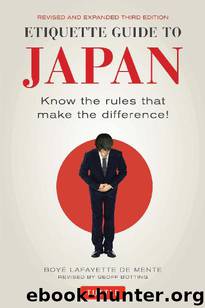Etiquette Guide to Japan: Know the rules that make the difference! by Boye Lafayette De Mente

Author:Boye Lafayette De Mente [De Mente, Boye Lafayette]
Language: eng
Format: epub
ISBN: 9784805313619
Publisher: Tuttle Publishing
Published: 2011-12-20T05:00:00+00:00
21
Japan’s Festival Culture
Some of the most impressive historical legacies that have been kept alive in Japan are matsuri (mot-sue-ree), or “festivals.” Virtually every village, town, and city, as well as thousands of temples and shrines throughout the country, celebrate one or more annual festivals.
Visitors who would like to see and experience one of the most interesting facets of Japanese life should take in a shrine or temple festival if the opportunity arises. Festival calendars are widely available at tourist information centers, travel agencies, and hotel concierge desks.
A limited calendar of the celebrations considered to be of special interest to foreign visitors includes a total of 271 matsuri. Travel books in English generally list only a very small number of these events—often the “big eight” or “big ten” festivals that take place in the largest cities and are seen as national events.
There are, in fact, thirteen festivals in Japan that are national holidays, some of which last for several days. Shogatsu (Show-got-sue) or New Year’s, begins on the eve of December 31 and ends on January 7, although many workers take additional days off.
The reason for the number and variety of matsuri in Japan can be traced to Shinto, which holds that all things in nature—trees, rocks, mountains, water, and so on—have spirits, and that people must remain on good terms with these spirits to prevent evil and destructive things from happening. Until the last decades of the nineteenth century, Japan’s economy was based on agriculture and depended on the success of seasonal harvests—and, therefore, on the cooperation of these natural spirits. Religious rituals became important traditions year round to ensure the spirits’ goodwill, inviting the appropriate deities to come down from heaven so the people could pray to them directly.
Matsuri to help ward off diseases and other calamities also became common. Some festivals were meant to ensure fertility; other festivals were designed to bring peace to the spirits of physical things—including broken and discarded sewing needles, harkening back to the time when most people made their own clothes. Paper lanterns, huge drums, gongs, masks, dolls, and historical images are fundamental parts of many Japanese festivals, as are fireworks.
In keeping with the Japanese love of structure and organization, the matsuri were (and are) made up of three parts. The first part is called kami mukae (kah-me muu-kigh), or “meeting the gods”; it is a ceremony held at a shrine or other sacred place to welcome the gods to the Earth. The deity concerned descends from heaven and takes up temporary residence in a palanquin-like portable shrine called a mikoshi (me-koh-she).
The second part of a festival, called shinkoh (sheen-koh), consists of participants carrying the mikoshi around rural communities and through the streets of towns and cities, generally accompanied by chants and some kind of music.
The third part of a matsuri is the kami okuri (kah-me oh-kuu-ree), or “god send-off,” a ritual to send the god concerned back to heaven.
Among the most popular of Japan’s annual festivals are the odori matsuri (oh-doh-ree mot-sue-ree)
Download
This site does not store any files on its server. We only index and link to content provided by other sites. Please contact the content providers to delete copyright contents if any and email us, we'll remove relevant links or contents immediately.
The Lost Art of Good Conversation by Sakyong Mipham(2123)
How We Talk by N. J. Enfield(1951)
F You Very Much by Danny Wallace(1705)
All-In (The Gamblers Book 1) by Sarah Curtis(1509)
How To Walk In High Heels: The Girl's Guide To Everything by Morton Camilla(1345)
The Art of Communicating by Thich Nhat Hanh(1244)
Botswana--Culture Smart! by Michael Main(1234)
Men and Manners by David Coggins(1117)
That's Not What I Meant! by Deborah Tannen(1080)
The Essentials of Business Etiquette by Barbara Pachter(1078)
Secrets of the Southern Belle by Phaedra Parks(1063)
Colloquial Hindi by Bhatia Tej K(1054)
50 Things Every Young Gentleman Should Know (GentleManners) by John Bridges & Bryan Curtis(957)
Would It Kill You to Stop Doing That: A Modern Guide to Manners by Henry Alford(954)
GQ How to Win at Life by Charlie Burton(952)
The Leader Phrase Book by Alain Patrick(947)
Etiquette in Society, In Business, In Politics, and at Home by Emily Post(945)
GQ How to Win at Life: The expert guide to excelling at everything you do by Burton Charlie(927)
Treating People Well by Lea Berman & Jeremy Bernard(918)
